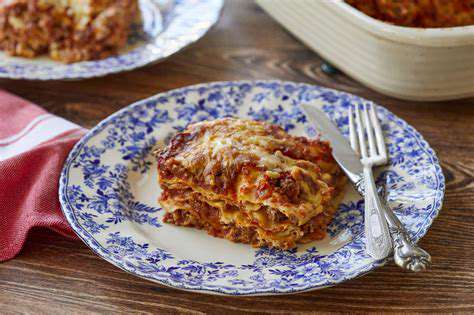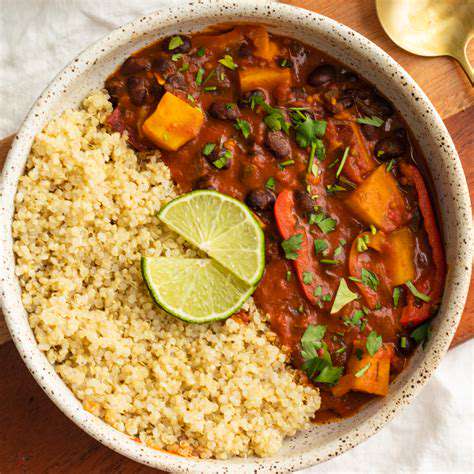Quick and Healthy Lunch Bowls
Choosing Your Base
Whole grains form the foundation of satisfying bowls that sustain energy for hours. Ancient grains like freekeh or amaranth offer novel textures while delivering complete protein profiles. For low-carb options, shredded Brussels sprouts or spiralized zucchini provide surprising substance. The base determines the eating experience - choose textures that please your palate while meeting nutritional goals.
Protein Powerhouses
Strategic protein selection impacts both satiety and flavor. Marinated proteins like citrus-herb chicken or miso-glazed salmon transform basic ingredients into craveable components. For plant-based options, pressed and baked tofu develops a meaty texture that stands up to bold seasonings. Remember that protein needs vary by activity level - adjust portions accordingly.
Veggie Variety
Vegetable selection should engage all five tastes - sweet roasted roots, bitter greens, umami mushrooms, etc. Raw, roasted, and pickled vegetables together create dynamic texture contrasts. Heirloom varieties add visual appeal while often containing higher nutrient levels than conventional produce.
Healthy Fats
Quality fats transform bowls from merely nutritious to truly satisfying. Toasted nuts and seeds add crunch while providing essential fatty acids. Avocado offers creaminess that mimics rich dressings with far better nutrition. Even modest amounts of high-quality fats significantly impact meal satisfaction.
Flavorful Dressings
Homemade dressings require minimal effort for maximum impact. A simple emulsion of olive oil, vinegar, and mustard can be customized endlessly with fresh herbs and spices. Yogurt-based dressings add protein while creating creamy textures without excessive calories.
Customization is Key
Successful meal prep accommodates changing cravings. Prepare neutral bases and proteins, then vary toppings and dressings throughout the week. This approach prevents boredom while maintaining nutritional consistency. Keep an assortment of global condiments to transform basic components.
Prep Ahead Strategies
Efficient prep relies on strategic sequencing. Roast vegetables while grains cook, then use residual heat to toast nuts. Portion dressings directly into small containers for grab-and-go convenience. These small efficiencies compound over multiple weekly preps.
Protein Powerhouses for a Satisfying Lunch
Lean Protein for a Light Lunch
Proper protein portions prevent afternoon slumps. Palm-sized portions of lean meats provide ideal satiety without heaviness. Cooking methods dramatically impact nutrition - poaching or sous vide preserves moisture without adding fats. Consider brining proteins before cooking to enhance both flavor and tenderness.
Plant-Based Protein Power
Legumes offer complete nutrition when properly prepared. Soaking and sprouting beans increases nutrient availability while reducing digestive discomfort. Fermented soy products like tempeh provide probiotics alongside protein. These techniques maximize the benefits of plant proteins.
Eggscellent Protein Options
Egg preparation affects nutrient retention. Soft-boiled eggs preserve heat-sensitive nutrients better than scrambled. For meal prep, pickled eggs offer extended shelf life with bold flavors. These variations keep egg-based meals interesting.
Protein-Packed Alternatives for a Quick Lunch
Dairy proteins provide convenient options. Strained yogurt (like skyr or labneh) concentrates protein while reducing lactose. For non-dairy alternatives, blended seed cheeses offer surprising protein density. These options work well for those needing quick, portable lunches.
Creative Combinations: Exploring Flavorful Variations

Fueling Innovation: The Power of Creative Combinations
Cross-cultural flavor fusions spark culinary creativity. Unexpected pairings like mango-jalapeño or tahini-maple often become new favorites. These combinations keep meal prep exciting while expanding your flavor repertoire. Don't hesitate to borrow ideas from global cuisines.
Unleashing the Potential of Diverse Perspectives
Seasonal availability inspires creative constraints. Farmers market finds often suggest their own perfect pairings. Limited seasonal ingredients force innovation that can lead to breakthrough combinations. This approach keeps meals aligned with nature's rhythms.
Harnessing the Synergy of Different Fields
Culinary science informs better combinations. Understanding flavor compounds helps create harmonious pairings. For example, sharing volatile aromatic molecules creates natural affinities between ingredients. This knowledge elevates intuitive cooking.
The Importance of Experimentation and Iteration
Successful combinations emerge through testing. Keep notes on proportions and preparation methods for repeatable results. Document both successes and learning experiences to refine your personal recipe collection. This systematic approach builds culinary confidence.
Read more about Quick and Healthy Lunch Bowls
Hot Recommendations
- Traditional Foods for Day of the Dead
- Food Etiquette in Italy: Pasta Rules!
- Best Family Friendly Restaurants with Play Areas in [City]
- Review: The Best [Specific Dessert] Place in [City]
- Top Ice Cream Parlors in [City]
- Traditional Foods for Halloween
- The History of the Potato in Ireland
- Best Vegan Pizza Joints in [City] [2025]
- Best Bakeries for Sourdough Bread in [City]
- Food Culture in Argentina: Asado and Wine


